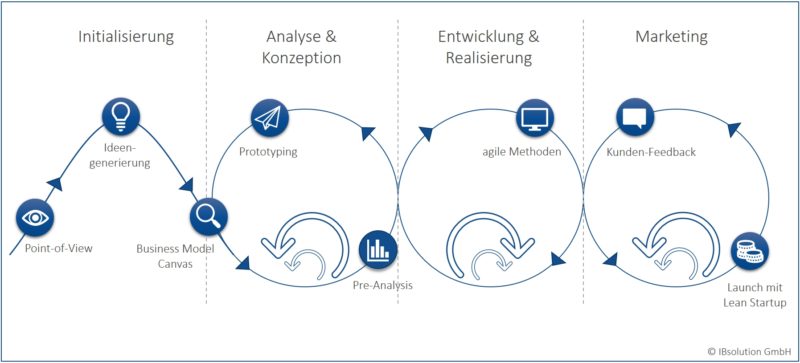In everyday life, digitalization has long been taking place, whether it is holiday planning with Airbnb or in the area of mobility when using Uber. It is almost indispensable in private life as well as in the working world. But not only large-scale conglomerates are affected by and are entering the process of digitalization. Every single company regardless of its size is in demand. The ultimate goal of the digitalization of medium-sized enterprises is to remain competitive.
Good news is, everyone can start its way into digitalization in only four steps. With the concept described here, every company manages to modernize without having to go through phases of despair or stagnation. Design thinking, as a creative process for searching ideas, is a tried and tested method on your way to digitalization. It goes through all four steps of the process and will ensure that out-of-the-box-way of thinking you need in order to come up with some unconventional ideas. With the help of as many different perspectives, challenges are solved creatively. The end result, your innovation, is focused on the needs of your customer. In the successive stages of the process, design thinking pursues various sub-goals, such as generating ideas, which is where you start.

Step 1: Initialization
First of all, it is about finding different concepts using customer analyzes for your project. This means you need a suitable idea, on the basis of which you can start the digitalization. And here, design thinking supports the creative process optimally. At the beginning, it is important that all team members understand the problem to be solved. In the following, you develop a suitable issue for your challenge. In the subsequent phase of the observation, the team analyzes your target group doing intensive research. The newly acquired knowledge serves as the basis for the further development. It helps you understanding the expectations and wishes of your customer. Next you collect as many ideas as possible. Which are, of course, then doublechecked to prove wether they generate profits or they are feasable and customer focused.
This proof can be done, for example, using the method of business model canvas, one of the most popular models to visualize concepts. Thereby you compare different options to finally create a suitable business model. As a result, you get a concept for your way into the digitization, which you further refine and follow during the next steps.
Step 2: Analysis and Conception
Now you want to further improve the concept using more detailed analyzes and prototypes. This is important to prevent complex rework and reduces development costs. So what you need to do is to explore the likely duration and way of the implementation, which precedes to prototyping. Meaning your team tests the feasibility by actually building first models. A prototype in the area of software development, for example, is a small part of the target software that is already running. Thus, problems that arise are apparent early and can be corrected even before the final software is developed or implemented.
Step 3: Development and realization
Next you actually develop your customer-focused product using agile development methods. Meaning you divide the whole process into short, manageable phases in which interim results are regularly checked and tested.
There are various possibilities for agile development, let me introduce you to the three most common agile methods in software development.
-
Ship-it-day means you have 24 hours to create a functioning result, such as a new process.
-
Hackathon is similar to Ship-it-day. Within a given timeframe, teams consisting of members from different areas of software development will develop a funtioning software product. If it proves to be useful, it is possible to include external persons, be it customers, partners or students.
-
Scrum works with intervals, so-called sprints, to complete the development packages. Once the scope of an interval is set, it remains unchangeable throughout the entire sprint. Exceptions are possible, when e.g. sudden problems occur. But new ideas or requirements will only be considered during the next sprints.
The development phase is characterized by repeated adjustments to optimize your final product. Remember, it's about developing a product that your CUSTOMERS want and need, regardless of how this product actually looks like in the end. Methods such as design thinking, rapid prototyping and agile development help you to gain new insights tand to continuously improve your product.
Step 4: Go to Market
So, well done so far, now all it takes is to finally launch your product. Following a lean startup approach, you have been able to your launch your product quickly and with reasonable project funding.
“Fail early, fail often, but always fail forward” (John C. Maxwell) means you need to establish a culture that embraces failure as long as it results in improvements. But this requires short product development cycles. New experiences and opinions initiate more and more of these cycles. So even after you launched your product there is still room for further improvements. And it is completely up to you wether to continue or to stop developing.
Conclusion: How do you find the way to digitalization? How do you digitalize your company? The answer is: Fast and effective in four steps. You have learned how to introduce digitalization in your company without stress. If you need help, you are welcome to contact us! We would love to support you with your project for the future.
![IBacademy_Logo_blau[496] IBacademy_Logo_blau[496]](https://www.ibsolution.com/hs-fs/hubfs/IBacademy_Logo_blau%5B496%5D.jpg?width=200&name=IBacademy_Logo_blau%5B496%5D.jpg)



